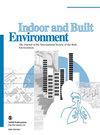Impact of buildings’ configuration in an urban context on the spread pattern of NO2 and indoor air quality: A CFD simulation
IF 2.9
3区 工程技术
Q2 CONSTRUCTION & BUILDING TECHNOLOGY
引用次数: 0
Abstract
The influence of the building’s configuration on the air flow pattern and the amount of pollutant entering the buildings was investigated. Six common forms of low-rise buildings in Shiraz City were evaluated as investigated patterns. Each of these forms were placed in four rotation modes (24 case studies in total) in an urban regular pavilion-shaped context, placed in the vicinity of an urban highway (as a source of pollutant production) and were simulated using Computational Fluid Dynamics (CFD). In this research, air velocity and NO城市中建筑物的布局对二氧化氮扩散模式和室内空气质量的影响:CFD 模拟
研究了建筑物的构造对气流模式和进入建筑物的污染物量的影响。设拉子市六种常见的低层建筑形式作为调查模式进行了评估。每种形式都以四种旋转模式(共 24 个案例研究)置于城市规则亭形环境中,并置于城市高速公路(污染物产生源)附近,并使用计算流体动力学(CFD)进行模拟。在这项研究中,空气流速和二氧化氮浓度被视为空气质量参数。使用 SST k-[计算公式:见正文]湍流模型对这些情况进行了稳定的三维流动模拟,该模型基于雷诺平均纳维-斯托克斯(RANS)方程进行数值求解。研究中使用的 CFD 软件与风洞试验进行了对比验证,结果可以接受。采用 TOPSIS 多标准决策法,在提高风速和减少建筑物内污染物量的基础上选择最佳方案。结果表明,最佳和最差的建筑形式分别与阶梯形和 L 形有关。研究结果为建筑师和城市设计师提供了改善建筑通风质量的设计方案。
本文章由计算机程序翻译,如有差异,请以英文原文为准。
求助全文
约1分钟内获得全文
求助全文
来源期刊

Indoor and Built Environment
环境科学-工程:环境
CiteScore
6.40
自引率
25.00%
发文量
130
审稿时长
2.6 months
期刊介绍:
Indoor and Built Environment publishes reports on any topic pertaining to the quality of the indoor and built environment, and how these might effect the health, performance, efficiency and comfort of persons living or working there. Topics range from urban infrastructure, design of buildings, and materials used to laboratory studies including building airflow simulations and health effects. This journal is a member of the Committee on Publication Ethics (COPE).
 求助内容:
求助内容: 应助结果提醒方式:
应助结果提醒方式:


